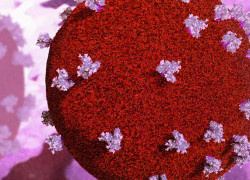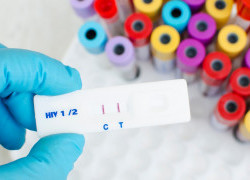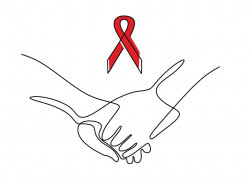In 2017, the Doherty Institute received $1.2 million from the Victorian State Government through the Department of Health and Human Services (DHHS) to establish the Melbourne HIV Cure Consortium (MHCC) – a collaborative research effort comprising experts in virology, immunology, drug development, neuroscience, and social research collaborating to accelerate efforts to find a cure for HIV.
Why a cure for HIV is needed
There are 36.7 million people living with HIV worldwide and for many it is now a manageable condition with antiretroviral treatment. In 2016, close to 20.9 million people were receiving antiretroviral therapy, which has saved many lives. However, the healthcare costs of maintaining HIV treatment are becoming more and more substantial, estimated to reach $19 billion by 2030.
In Australia, HIV prevalence is relatively low and people living with HIV have good access to treatment. However, in living longer, these patients have increasingly more complex health problems, estimated to cost the Victorian economy tens of millions of dollars each year.
Finding a cure for HIV – or a way for patients to safely stop antiretroviral therapy and keep their virus under control – will have a very significant global and local economic and social impact. The main reason cited by scientists for why HIV cannot be cured is because of HIV latency, or when the virus ‘goes to sleep’ in specific immune‐fighting cells called resting T‐cells.
Thanks to funding from the DHHS, working closely with affected communities, key research institutes specialising in HIV based in Melbourne including the Doherty Institute, The Alfred Hospital, the Burnet Institute, RMIT and Latrobe University have combined their multi-disciplinary expertise to form the MHCC and make Melbourne a world-leader in HIV cure research.
Aims of the Consortium
- Build scale in world‐leading HIV cure research and training through innovative interventional clinical trials.
- Conduct fundamental, clinical and community-based research for an HIV cure.
- Build capability in translational activities including drug and diagnostic discovery.
- Strengthen partnerships between HIV cure researchers across Victoria and related key disciplines such as transplantation, vaccination, epigenetics and drug development.
- Leverage competitive grant funding.
- Establish a Victorian HIV Cure Research Community Advisory Board.
With the initial funding provided by DHHS, Consortium activities will focus on developing significant Melbourne based clinical trial(s) that will engage biomedical and social researchers. As additional funding is secured, the Consortium’s activities will expand.
It is anticipated that the Consortium will ultimately support investigator-initiated and industry-sponsored drug development and clinical trials. Funding will be used to support the following main activities:
- Drug screening in vitro
- Biomarker evaluation
- Clinical trials
Activities of the Consortium
Current activities under the Consortium are made up of three components:
- Community Advisory Board formation and training.
- Small grants scheme – annual process for grants between $10,000 and $20,000 (for any type of study related to HIV cure including social research, community engagement, community literacy, early discovery, assay development (up to $60,000 per annum will be distributed).
- Large grants of maximum $450,000 will be allocated to clinical trials only. Trials must be interventional and have multiple sites. This funding will be used to leverage extra investment.
Community Advisory Board
Current Community Advisory Board (CAB) representatives include board members of Throne Harbor Health, specialist policy advisors from Living Positive Victoria, Positive Women Victoria and Thorne Harbour Health and those with lived experience.
Mission
The mission of the CAB is to integrate community perspectives into HIV cure research to foster meaningful advances in the finite treatment of people living with HIV and AIDS.
The CAB provides an opportunity for affected communities to:
- Forge a viable partnership that will lead to improved knowledge of HIV and AIDS and potentially an HIV cure.
- Promote ethical research purposes and practices.
- Ensure relevance and acceptability of research performed by the MHCC. Voice potential concerns regarding specific studies, their development, potential risks for participants, implementation and outcomes.
- Better understand research processes and new scientific findings.
- Give guidance on complex issues including those related to the accrual and retention of trial participants. CAB members will establish mechanisms to facilitate people living with HIV outside of metropolitan Melbourne to participate in HIV cure research.
- Provide advice on research priorities for HIV community including social research.
To fulfil their mission, CAB members will be offered scientific and leadership training based on their specific needs and their time will be compensated.
Composition
The CAB is composed of five members selected based on the interest and expertise in HIV cure research. The CAB strives for its membership to reflect the demographics of the HIV epidemic in Victoria and Australia, stressing inclusion of traditionally underserved communities. CAB membership is open to persons living with and affected by HIV and AIDS, representatives from the private sector, local and state health departments, community-based organisations (CBOs), HIV service providers, educational institutions, and others working or volunteering in the HIV and AIDS field. The majority of members will be openly living with HIV and AIDS (three persons).
Members
The MHCC Community Advisory is in the process of recruiting new members. Once this process has been finalised, the new members will be listed on this page.





